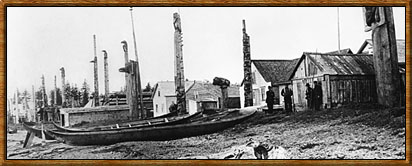 
(Page 1 of 3) |
Masset

The Haida called this town Uttewas (or White Slope Town), after the shells from countless mollusc dinners of the past scattered on a nearby hill. The hill itself was called Idjao, and the houses south of it formed a separate village when the first Europeans and New Englanders arrived. The two settlements amalgamated in the middle of the last century to form Masset.
In 1792, while on board the ship Columbia commanded by Captain Robert Gray, Joseph Ingraham made a drawing of three villages on Masset Inlet. Probably the one closest to the spit on the east side of the inlet is Masset, the one to the south on the same shore is Kayung and the third village on the western shore is Yan.
The hill at Masset was being used as a fort when Lieutenant Camille de Roquefeuil of France explored the inlet in September 1817:
There is something picturesque in the whole appearance of this large village. It is particularly remarkable for the monstrous and colossal figures which decorate the houses of the principal inhabitants, the wide gaping mouths of which serve as a door . . . Ascending the arm of the sea, there is, on the north side, above the largest village, a fort, the parapet of which is covered with beautiful turf, and surrounded by a palisade in good condition.
From the mid-1830s on, the people of Masset and surrounding villages made annual trading voyages to the Hudson's Bay Company post at Fort Simpson on the mainland to sell the quantities of potatoes they grew. Reverend Jonathan Green saw potatoes growing at villages on North Island in 1829 and thought that the Haida had been cultivating them for a long time before his visit. In 1839, another visitor to Haida Gwaii, John Dunn, also noted the Haida trade in potatoes: "I have known from five to eight hundred bushels traded in one season from these Indians at Fort Simpson." Each spring, large fleets of canoes left Masset to trade at Fort Simpson and to take part in the eulachon fishery at the mouth of the Nass River. The Haida often fought with the Tsimshian on these occasions, as noted in the Hudson's Bay Company journal entry for September 14, 1837.


This view of Masset was taken in 1878 before any European-style houses were built. Within a decade, most of these dwellings had been torn down and the totem poles chopped up for firewood.
Photograph by George M. Dawson.
National Archives of Canada 259. |

The first fur trading post on Haida Gwaii was privately established at Masset in 1853, but it was taken over by the Hudson's Bay Company under Alexander McKenzie in 1869. His account of Masset covers nearly a decade and provides many interesting descriptions of Haida activities. The active trade with Europeans and Americans from the late eighteenth century until the arrival of missionaries at Masset in 1873 did little to change Haida beliefs or their symbolic and artistic expressions. In many ways, they were enriched by new forms of wealth to which they had ready access, and slavery continued here well after it ended elsewhere in Canada and the United States. Around 1850 Chief Albert Edward Edenshaw owned twelve slaves and brought some of them to Masset when he moved there in 1883. George M. Dawson notes that chiefs in Masset still had slaves at the time of his visit in 1878.
|